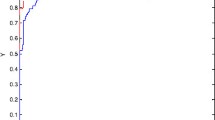Abstract
Conjugate gradient methods are appealing for large scale nonlinear optimization problems. Recently, expecting the fast convergence of the methods, Dai and Liao (2001) used secant condition of quasi-Newton methods. In this paper, we make use of modified secant condition given by Zhang et al. (1999) and Zhang and Xu (2001) and propose a new conjugate gradient method following to Dai and Liao (2001). It is new features that this method takes both available gradient and function value information and achieves a high-order accuracy in approximating the second-order curvature of the objective function. The method is shown to be globally convergent under some assumptions. Numerical results are reported.
Similar content being viewed by others
References
M. Al-Baali, “Descent property and global convergence of the Fletcher-Reeves method with inexact line search,” IMA Journal of Numerical Analysis, vol. 5, pp. 121-124, 1985.
Y.H. Dai and L.Z. Liao, “New conjugacy conditions and related nonlinear conjugate gradient methods,” Applied Mathematics and Optimization, vol. 43, pp. 87-101, 2001.
Y.H. Dai, J.Y. Han, G.H. Liu, D.F. Sun, H.X.Yin, and Y.Yuan, “Convergence properties of nonlinear conjugate gradient methods,” SIAM Journal on Optimization, vol. 10, pp. 345-358, 1999.
J.C. Gilbert and J. Nocedal, “Global convergence properties of conjugate gradient methods for optimization,” SIAM Journal on Optimization, vol. 2, pp. 21-42, 1992.
J.J. Moré, B.S. Garbow, and K.E. Hillstrom, “Testing unconstrained optimization software,”ACM Transactions on Mathematical Software, vol. 7, pp. 17-41, 1981.
J. Nocedal and S.J. Wright, Numerical Optimization, Springer Series in Operations Research, Springer-Verlag: New York, 1999.
M.J.D. Powell, “Nonconvex minimization calculations and the conjugate gradient method,” in Lecture Notes in Mathematics, no. 1066, Springer-Verlag, Berlin, 1984, pp. 122-141.
J.Z. Zhang, N.Y. Deng, and L.H. Chen, “New quasi-Newton equation and related methods for unconstrained optimization,” Journal of Optimization Theory and Applications, vol. 102, pp. 147-167, 1999.
J.Z. Zhang and C.X. Xu, “Properties and numerical performance of quasi-Newton methods with modified quasi-Newton equations,” Journal of Computational and Applied Mathematics, vol. 137, pp. 269-278, 2001.
G. Zoutendijk, “Nonlinear programming, computational methods,” in Integer and Nonlinear Programming, J. Abadie (Ed.), North-Holland: Amsterdam, 1970, pp. 37-86.
Author information
Authors and Affiliations
Rights and permissions
About this article
Cite this article
Yabe, H., Takano, M. Global Convergence Properties of Nonlinear Conjugate Gradient Methods with Modified Secant Condition. Computational Optimization and Applications 28, 203–225 (2004). https://doi.org/10.1023/B:COAP.0000026885.81997.88
Issue Date:
DOI: https://doi.org/10.1023/B:COAP.0000026885.81997.88




